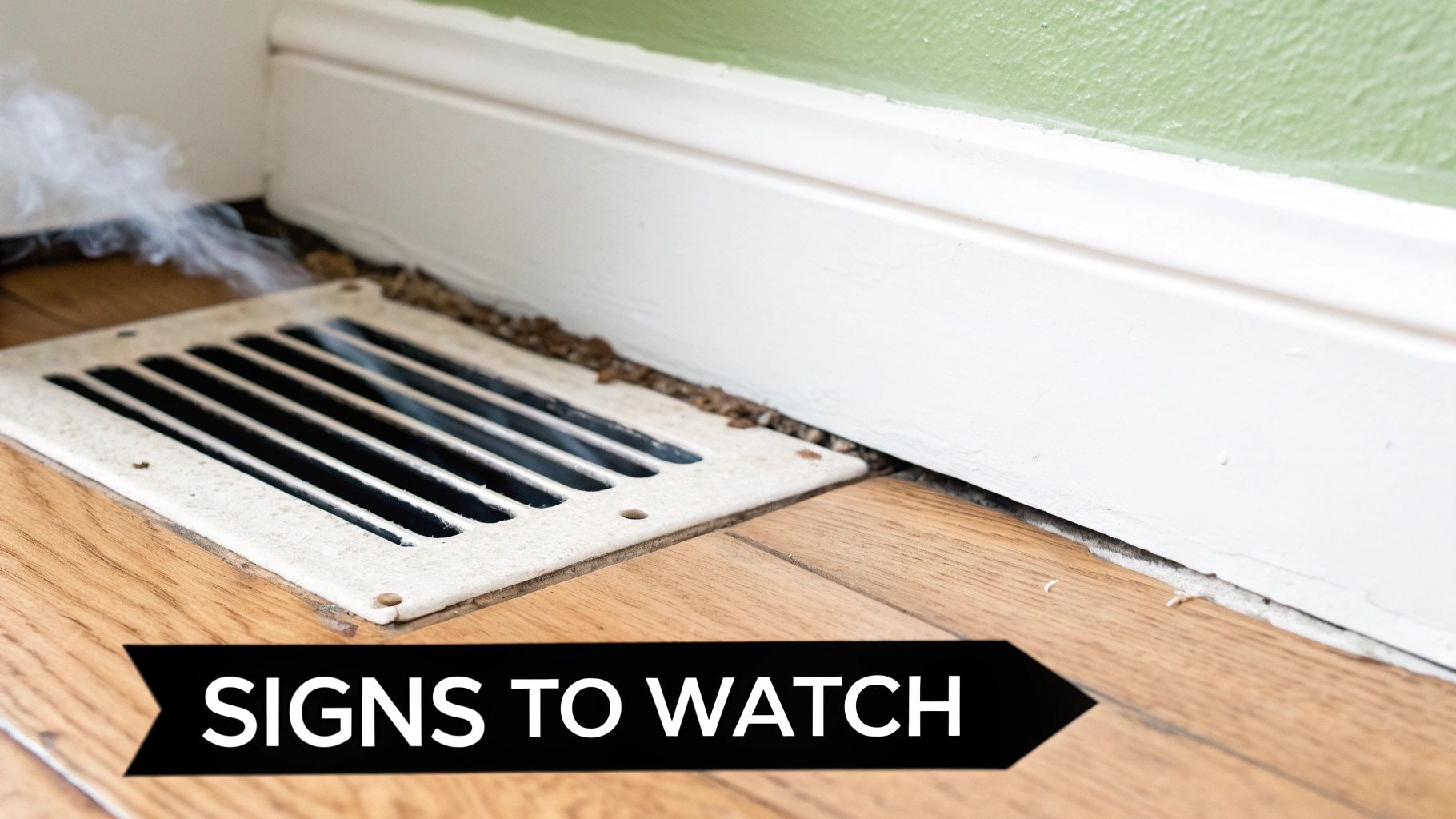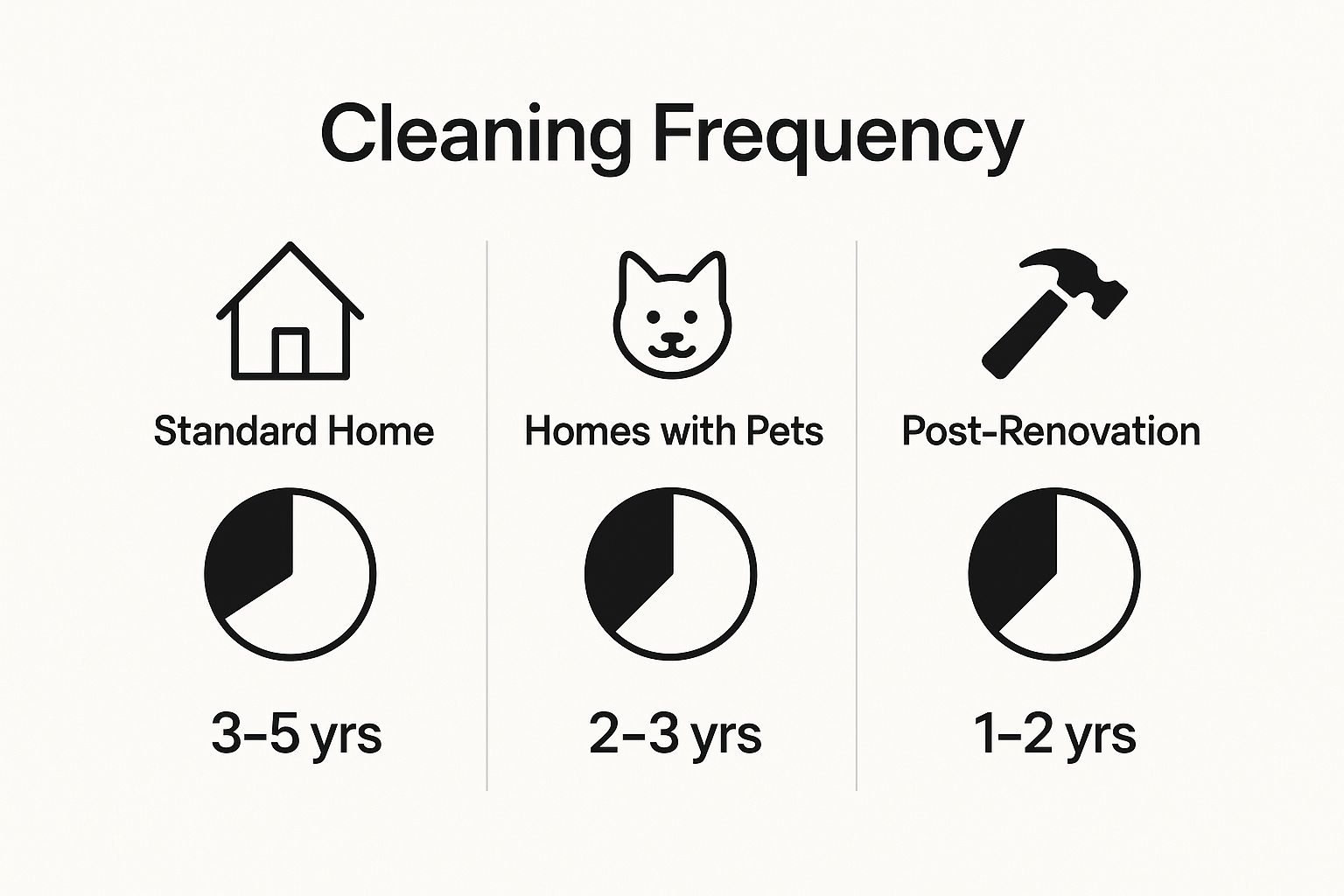Here’s a question I get all the time: is air duct cleaning necessary? The honest answer is… it depends. It's definitely not a routine chore every single homeowner needs to worry about, like changing a furnace filter. Think of it more like a targeted deep clean for specific, and thankfully uncommon, problems.
The Real Verdict on Air Duct Cleaning

Picture your home’s ductwork as its lungs, silently circulating air to keep every room comfortable. Most of the time, this system works just fine on its own. But sometimes, things can go wrong that turn this network of clean air pathways into a breeding ground for nasty contaminants.
A lot of the confusion around duct cleaning comes from aggressive marketing. Some companies will try to sell it as a yearly must-do for every home, but that's just not backed up by the experts, including the U.S. Environmental Protection Agency (EPA). For the average, well-kept home, there's little proof that a routine cleaning does much for air quality or energy bills. But that’s where the story gets more interesting.
When Cleaning Becomes Essential
The real question isn't if cleaning is ever needed, but when. It’s less about routine maintenance and more about solving a specific problem. A professional service becomes a non-negotiable when your ducts are actively making your home unhealthy or uncomfortable.
To help you figure out if your home falls into this category, here's a quick checklist.
Quick Assessment: Should You Clean Your Air Ducts?
Use this checklist to quickly determine if your home could benefit from a professional air duct cleaning service.
| Situation or Symptom | Is Cleaning Recommended? | Primary Reason |
|---|---|---|
| Visible Mould Growth on Ducts or HVAC | Yes, Immediately | Health Risk: Spores can circulate through the home. |
| Pest Infestation (Rodents, Insects) | Yes, Immediately | Health & Contamination: Pests leave behind droppings and nests. |
| Visible Debris Blowing from Vents | Yes | Contamination: A clear sign of a significant buildup. |
| Recent Major Renovations | Yes | Debris Control: Construction dust and materials clog the system. |
| Unexplained Allergies/Illness | Possibly | Investigation Needed: Could be a contributing factor. |
| Musty Odours from Vents | Possibly | Investigation Needed: Often a sign of mould or moisture. |
| It’s Been 5-7 Years Since Last Clean | Maybe | Preventive Maintenance: Good practice, but not urgent without symptoms. |
| Buying a New Home | Maybe | Peace of Mind: You don't know the history of the system. |
Basically, if you can tick off one of the "Yes, Immediately" boxes, it’s time to call in the pros. Here’s a bit more on those critical situations:
- You can see mould: If you spot mould growing on the inside of your ducts or on parts of your furnace or AC, that’s a major red flag. Don't wait.
- You've had pests: Finding out that rodents or insects have been living in your ductwork is a clear signal. You'll want a thorough cleaning and sanitizing to get rid of their nests and droppings.
- You're seeing dust and debris blowing out: If your vents are visibly spitting out particles when the system kicks on, your ducts are clogged and need immediate attention.
In these cases, air duct cleaning stops being an optional "nice-to-have" and becomes a necessary step to get your home's air back to a healthy, functional state. It’s all about fixing a real, confirmed issue.
Getting a handle on what a proper cleaning involves can also give you peace of mind. To see what a professional service actually does, check out our guide on what is air duct cleaning. It will help you spot the difference between a quick, superficial job and a comprehensive service that solves the root problem.
How Dirty Ducts Affect Your Family's Health

Let’s cut to the chase. The number one question homeowners ask is simple: is air duct cleaning necessary to keep my family healthy? While a routine cleaning might not be essential for every single home, the health benefits become crystal clear in certain situations, especially when you have vulnerable family members.
Think of your HVAC system like your home's lungs. The ductwork is the network of airways, breathing air into every room. If those airways are dirty, your home is breathing in and circulating pollutants that can tank your indoor air quality.
For the most part, your furnace filter does a decent job catching the big stuff. But over the years, the really fine particles—dust, pet dander, pollen, and other allergens—make their way past the filter and settle deep inside the ductwork, building up a hidden reservoir of irritants.
The Vicious Cycle of Contamination
Every time your furnace or AC kicks on, it forces a blast of air through those ducts. This powerful airflow picks up all those settled particles and launches them right back into the air you’re breathing. Suddenly, the very system that’s supposed to provide comfort is actively polluting your home.
This cycle is a real problem for households with:
- Children and the Elderly: Their respiratory systems are either still developing or more sensitive, making them more susceptible to airborne nasties.
- Anyone with Asthma or Allergies: The constant circulation of dust mites, pet dander, and mould spores can easily trigger or worsen their symptoms.
- Family Members with Chronic Respiratory Issues: Poor air quality can aggravate conditions like COPD or chronic bronchitis.
It’s just like turning on a fan that’s been sitting in the corner collecting dust. Even if you just cleaned the room, that fan is going to spray a fine layer of dust over everything. Your HVAC system can do the same thing, but on a house-wide scale.
When Cleaning Becomes a Health Priority
While not every home needs it, duct cleaning becomes a non-negotiable health investment when certain contaminants show up. The link between dirty ducts and health problems is undeniable when you're dealing with mould or a pest infestation.
Mould, for instance, is a major health red flag. If moisture gets into your ductwork and mould starts to grow, your HVAC system becomes a perfect delivery service, spreading microscopic spores into every room. This can lead to serious allergic reactions and respiratory issues. Likewise, pests leave behind droppings and dander that are both unsanitary and highly allergenic.
In these cases, air duct cleaning isn't just about getting rid of dust. It's about removing a direct threat to your family's health and well-being. Getting that source of contamination out of your home is the first and most critical step toward a healthier living environment.
So, while the average household might not notice a night-and-day difference, the story completely changes if you have sensitive individuals or a confirmed contamination problem. For these homes, a professional cleaning can turn your ductwork from a source of irritation into a neutral pathway for genuinely clean air, offering priceless relief and peace of mind.
Can Clean Air Ducts Lower Your Energy Bills?
Duct cleaning companies often talk a big game about energy savings, but the truth is a little more complicated. While a good cleaning can certainly help, the real key to lowering your utility bills lies in understanding how your ductwork actually impacts your HVAC system's performance.
Think of it this way: trying to breathe through a clogged-up straw during a long run. That's what your furnace or air conditioner is doing when its ducts are packed with years of dust and debris. All that gunk restricts airflow, forcing the system to run harder and longer just to hit the temperature you set on the thermostat.
That extra work isn't free. It shows up directly on your energy bill. When you clear out those blockages, you’re basically letting your system take a full, deep breath again, which naturally makes it more efficient.
Beyond Cleaning to True Efficiency
Here’s the thing, though: a dirty duct is one problem, but a leaky one is often much, much worse. Leaks in your ductwork let all that expensive heated or cooled air escape into your attic, crawlspace, or behind walls before it ever makes it to your rooms. It's a massive energy vampire.
This isn't a rare issue affecting only old homes. It's surprisingly common, even in newer builds. Take California, for example, where building codes are strict about proper ventilation. A study on homes built between 2011 and 2017 discovered that duct leaks were responsible for about one-third of the energy used for heating and cooling. Simply sealing those leaks could have saved a huge chunk of that wasted energy.
The most effective approach combines both services. Sealing duct leaks stops energy waste right at the source, while cleaning ensures the air that is delivered flows freely. When you do both, you get a genuinely efficient system.
A Holistic View of Home Performance
For the best results, stop thinking about duct cleaning as a standalone task. Instead, see it as one part of a bigger home efficiency puzzle. Clean ducts, sealed leaks, and regular HVAC maintenance all work together, allowing your system to run at its absolute best. This combined strategy is what really delivers those big savings.
While we're focused on air ducts here, it’s helpful to see how this principle applies elsewhere. You can learn more about cleaning's impact on energy efficiency to understand the broader concept.
So, when you ask is air duct cleaning necessary for energy savings, you're really uncovering a bigger truth. Cleaning is a great start, but teaming it up with duct sealing and routine HVAC service is the real power move for lowering your energy bills for good.
Clear Signs Your Air Ducts Need Cleaning

Instead of just guessing or sticking to a rigid schedule, you can actually learn to spot the tell-tale signs that your ductwork is crying out for help. Your home is pretty good at giving you clues when something's off with its HVAC system. You just need to know what to look, listen, and even smell for.
Think of it like being a detective for your home’s respiratory system. Your mission is to find the symptoms pointing to a deeper problem hiding in the ducts. Some signs are blatant and impossible to ignore, while others are a bit more subtle and require a keener eye.
Obvious Red Flags You Can See
These are the dead giveaways that your ductwork is compromised and needs a professional cleaning, stat. If you spot any of these, it’s time to pick up the phone.
- Visible Mould Growth: If you see any black, green, or white fuzzy stuff growing on or around your air vents, registers, or—worse—inside the ducts themselves, that’s a major problem. Mould spores can get blown all over your house, creating a serious health hazard.
- Signs of a Pest Infestation: Finding insect casings, rodent droppings, or bits of nesting material in your ducts is a sure sign you’ve had some unwanted tenants. These critters leave behind waste that you definitely don’t want circulating through your living room.
- Puffs of Dust from Vents: Does a little cloud of dust shoot out of your vents every time the heat or AC kicks on? That means the ducts are so packed with gunk that they literally can’t hold it all in anymore.
Subtle Clues to Investigate Further
These signs might not be as dramatic, but they often point to a significant buildup of contaminants that could be quietly wrecking your home's air quality and comfort.
A persistent musty or stale smell that you can't trace, especially one that only seems to pop up when the furnace or air conditioner is running, is a classic sign. It often points to mould, mildew, or even decaying organic matter trapped deep inside the ductwork.
Another clue? A sudden spike in allergy-like symptoms among your family members, but only when they're inside. If the sneezing, coughing, and watery eyes get worse at home, your air ducts could be the culprit, circulating a heavy load of allergens.
If you've just completed a major home renovation, the fine dust from drywall, wood, and other materials can easily overwhelm your HVAC system. A post-renovation cleaning is often a necessary step to clear out this heavy-duty debris.
Finally, pay attention to your comfort. If some rooms suddenly feel like a sauna while others are an icebox, it could mean blockages in the ductwork are choking off airflow to certain areas. While other things can cause this, clogged ducts are a very common offender. If you notice these clues, it's worth a closer look to see if a good duct cleaning is the answer.
Finding the Right Duct Cleaning Schedule
You’ve probably heard the old rule of thumb: clean your air ducts every three to five years. While that’s a decent starting point, it’s not a one-size-fits-all answer. Every home is different. Your environment, lifestyle, and even your home's history all determine how quickly your ductwork actually gets dirty.
The key is to create a personalized schedule. This way, you avoid wasting money on cleanings you don't need yet, but you also don't wait so long that your air quality suffers.
Several things can speed up how fast dust and gunk build up in your HVAC system. If you have pets that shed, you can bet that dander and fur are accumulating much faster than in a home without furry friends. Similarly, if anyone in your family struggles with allergies or asthma, more frequent cleaning can make a real difference by reducing airborne irritants.
Just finished a big renovation? That’s another major culprit. All that fine dust from drywall, sanding, and sawing gets sucked right into your vents. A post-reno cleaning is almost always a good idea.
Personalizing Your Cleaning Timeline
Take a moment to think about your specific situation. Do you live near a construction site or a high-traffic road? Does anyone smoke indoors? Answering questions like these helps you move past a generic guideline and land on a schedule that actually makes sense for your home.
This infographic breaks down how different factors can change the recommended cleaning frequency.

As you can see, things like having pets or wrapping up a renovation can easily cut the standard waiting time by more than half.
Even the National Air Duct Cleaners Association (NADCA) notes that their three to five-year recommendation shortens when other variables come into play. For example, a family with two dogs living in a humid, coastal part of Canada might need to get their ducts cleaned every two years to keep their indoor air fresh. You can explore more expert takes on how often air ducts need cleaning at 1cleanair.ca.
By evaluating your home's unique conditions—from pets and renovations to local environmental factors—you can establish a cleaning schedule that truly protects your air quality and HVAC system efficiency.
Professional Cleaning Versus a DIY Approach
So you've noticed your vent covers are looking a little grimy. It's tempting to just grab your vacuum's hose attachment and suck up the dust yourself, right? I get it. But before you do, let's talk about what that actually accomplishes.
Cleaning just the vent registers is like tidying up the front doormat but leaving the rest of the house a mess. You're hitting the most obvious spot, but you're missing the real problem hidden deep inside the walls. A DIY job can only reach a few inches into the ductwork, leaving the vast majority of the system—where all the serious gunk lives—completely untouched.
The Difference in Tools and Training
Here’s the thing: you just don't have the right gear for the job. And that's okay! Professionals roll up with heavy-duty, truck-mounted vacuums that create immense negative pressure through your entire duct system. This powerful suction is non-negotiable; it ensures that every bit of dust, dander, and debris they dislodge gets pulled out of your home, not blown back into your living room.
Once that vacuum is running, technicians feed specialized tools like high-speed rotary brushes and compressed air whips deep into the ductwork. These tools aggressively scrub the inside surfaces, breaking loose years of caked-on buildup that your household vacuum wouldn't even budge.
A DIY attempt often does more harm than good. You might just stir up concentrated pockets of dust, sending a cloud of allergens and contaminants straight into the air you breathe. A professional service contains and removes it all.
DIY vs Professional Air Duct Cleaning A Head-to-Head Comparison
Choosing between a weekend project and calling in a pro comes down to understanding the massive difference in results, safety, and long-term value. While the low upfront cost of DIY is appealing, the risks and sheer ineffectiveness often make it a poor choice.
Let's break down exactly how the two approaches stack up against each other.
| Aspect | DIY Approach | Professional Service |
|---|---|---|
| Effectiveness | Low: Cleans only the visible vent openings. Misses the main problem areas. | High: A comprehensive clean of the entire system, from every vent right back to the furnace. |
| Equipment | Standard household vacuum and maybe a brush. | High-powered negative air machines, air whips, and rotary brushes. |
| Risk | High: You could easily damage fragile ductwork or just push debris further in. | Low: Trained and insured technicians use the right methods to protect your system. |
| Air Quality Impact | Can actually make air quality worse by releasing trapped contaminants. | Dramatically improves air quality by safely containing and removing all debris. |
| Time | Several hours for a job that's mostly superficial. | A full, deep clean is usually done in 2-4 hours. |
| Cost | Low initial cost, since you're just using tools you already own. | A higher upfront investment, but it comes with guaranteed, professional results. |
Ultimately, a professional service delivers a truly clean system, giving you peace of mind that the job was done right and your home's air is as healthy as it can be.
Common Air Duct Cleaning Questions Answered
So, you’ve decided that duct cleaning might be a good move for your home. But what now? Most homeowners have a few practical questions about how it all works, what it costs, and who to trust. Let’s get you some straight answers.
How Much Does Professional Air Duct Cleaning Cost in Canada?
For a typical home in Canada, you can expect to pay somewhere between $400 and $800 for a professional service. Of course, that price can shift depending on how big your house is, the complexity of your ductwork, how much gunk is built up, and where you are in the GTA.
It's a good idea to get detailed quotes from a few different companies. A quick word of warning: be skeptical of those "too good to be true" deals. Bargain-basement prices often mean you’re getting a cheap, incomplete job that skips over critical parts of your HVAC system, or worse, it's a flat-out scam.
How Do I Find a Reputable Duct Cleaning Company?
Your best bet is to look for companies certified by the National Air Duct Cleaners Association (NADCA). Members have to stick to a strict code of conduct and high cleaning standards, so it’s a great starting point.
Beyond that, do your homework. Check recent online reviews, ask to see their liability insurance, and always get a written quote that spells out exactly what they’ll be doing. A real pro will be happy to answer all your questions without giving you a high-pressure sales pitch.
You might be wondering if it's a messy process. It shouldn't be! Reputable companies use powerful truck-mounted vacuums that create negative pressure inside your ducts. This means all the dust, pet dander, and debris they dislodge gets sucked directly into their containment unit, not into your living room. The whole thing usually takes just a few hours with minimal disruption to your day.
If you're ready to ensure your home’s air is as clean and healthy as it can be, Can Do Duct Cleaning offers expert, NADCA-certified services across the GTA. With over 30 years of hands-on experience, our team delivers a thorough, mess-free cleaning that’s right for your home. Get your free, no-obligation quote today at https://www.candoductcleaning.com.


